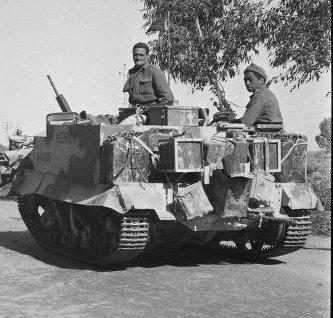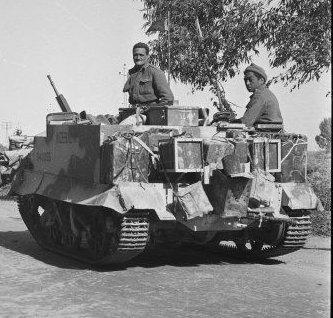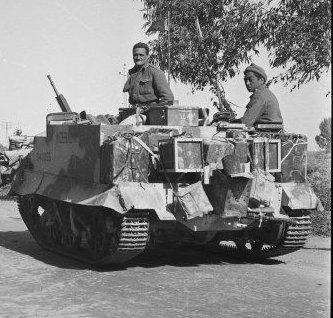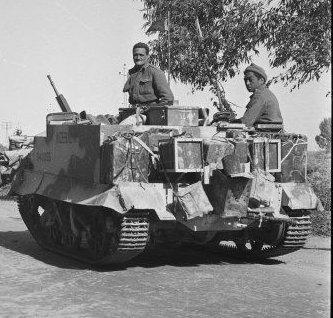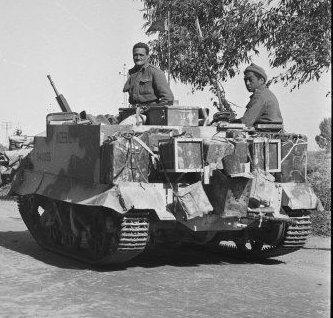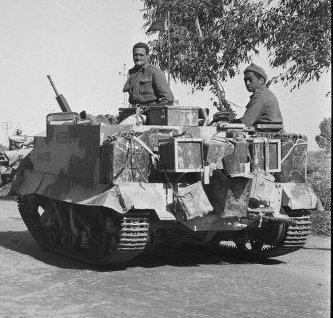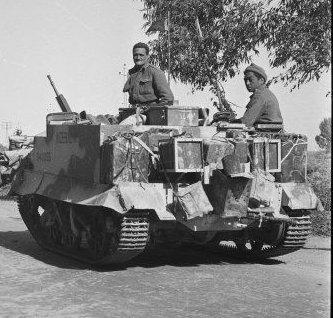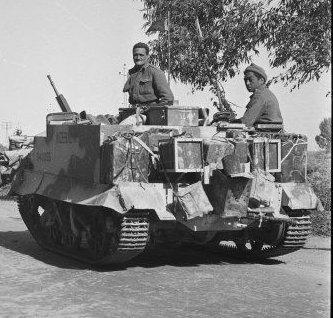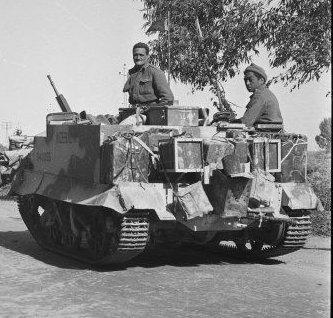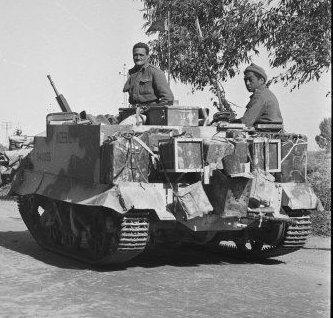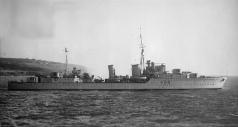<p><strong>Te Tohara (Charlie) Mohi grew up in Pakipaki. He embarked for war in 1941 and served with the Maori Bren-carrier platoon. </strong><strong>Charlie returned on furlough in 1945, see the photo <a href="/node/22923">here</a>.</strong></p><p><strong>After leaving New Zealand the Reinforcements docked at Freemantle for a short while.<br /></strong></p><h2><strong>Transcript<br /></strong></h2><p><strong>Te Tohara Mohi: </strong>Engari te taenga atu ahua tata atu matou ki Ahitereiria ra, ko au tetahi ano te, o te, o nga Kaari o te o te tima, ta matou mahi e whakatutu haere i a matou to matou Apiha, e kore e maungia atu he pia ki waho, e tama, i aua wa ra kua pia katoa nga wa, nga tima. </p><p>To matou taenga atu ki a Freemantle, ki Perth. Tae atu matou ki Freemantle, a, kare matou e tukua kia haere ki runga i te whenua haere, oh, ki roto i te taone. Te mataku o nga, o matou apiha, kei puta atu matou kare hoki e whakaengia nga Ahitereiria kia haere atu ki te whenua ra. No te mea ko tera te tuatahi o nga raupatutanga i a ratou, o nga hoia o tera taha. A, ka tuku atu a ratou kia hoki atu ki to ratou whenua, hei, ngaro to reo. A, koa oti ta matou mahi i reira ka tae mai nga tima o, o tahaki, mau mai ngia a nga kai mo to matou waka, mo to matou tima, a, nga mea toa o matou kua heke atu ki runga i nga, ki nga tima paku, a hoki atu ki te, ki te taone, ki reira karia ka haere. Mahi porangi, haurangi noa, a, ka karangahia matou kia haere ki te tiki, ah well, to matou taenga atu ki reira, ka ngaro ano hoki matou.</p><p>Koinei nga mahi tinihanga, nga mahi a te hoia, to matou hoki mai tanga ki, ki runga i to matou waka, ah well, ka karanga mai ngia e Bully Jackson, “Haramai Mohi.” I said, “He aha tena Bully?” “Kia tangongia atu te mea nei.” A, ko Bully hoki to matou apiha, a ko Bully ae, he Apiha pai.</p><p><strong>Pou Temara: </strong>Ana, ka tangohia atu nga stripes.</p><p>A, ka tangongia atu. E rua, toru, iwa kare tahi hoki he Heihana naku i timata ka homaingia ano.</p>
Media library
Audio
<p><strong>Sound file</strong> from Ngā Taonga Sound & Vision, ref: <a href="https://www.ngataonga.org.nz/collections/catalogue/catalogue-item?recor…;. Any re-use of this audio is a breach of copyright.</p><p><strong>Image<br /></strong>Crop of <a href="/node/3856" target="_blank">full photo</a> - Bren-carrier platoon leads the Maori Battalion into Tripoli, 23 January 1943. Sgt Te Whiu Purei (standing) and Charlie Mohi, seated.</p>
<p><strong>Te Tohara (Charlie) Mohi grew up in Pakipaki. He embarked for war in 1941 and served with the Maori Bren-carrier platoon. </strong><strong>Charlie returned on furlough in 1945, see the photo <a href="/node/22923">here</a>.</strong></p><p><strong>When Charlie arrived in Egypt on June 29th, 1941 he was admitted into hospital with a bout of pnuemonia. Here he recounts his experience in the South African run hospital in Suez. <br /></strong></p><h2>Transcript</h2><p>Ta matou mahi. Engari to matou taenga atu ki Ihipa, e, ka pa ki au te pneumonia. I te po tonu, e ta, i te ata tonu he hekeheke ana matou ka taenga atu e au te mau i aku peke i te taha, hinga tonu atu au, hemo tonu atu! A ka maungia i au ki ro hohipera, i Sudan, a Suez. Ka maungia au ki ro hohipera i reira, a, kua tangotango ke aku, aku tikiti, kare e mohio ke te iwi ra he aha he mangumangu, he aha ranei. Engari he toru pea nga ra katahi ano ka oho, i te kaha o te mauiui. Engari, taku ohotanga titiro atu au he Pakeha, he wahine Pakeha. Ka korero mai ki au – “are you Maowri?” Ka ruru atu taku mahunga, ka moe ano. Engari taku ohotanga, i mutu atu taku mauiuitanga, e tama, i roto au i mea, I te hohipera o nga South Africans - te iwi kare nei pirangi te mangumangu. Aue, ka pau te wehi taua iwi ra. Engari, hei aha maku. Korero mai ki au, e karawhiungia atu te Maori. Mohio tonu he ahua pai ke atu toku maramatanga toku mohiotanga i to ratou. E toru wiki au e noho ana i reira, a ka hoki atu au ki to matou ope, i te, i reira e tereina ana i Maadi. </p><p>Kua haere ke etahi o oku hoa ki te Battalion, e noho mai ana ratou, katahi tonu etahi o ratou hoki mai i mea i Greece, i Crete to ratou pana mai tanga e te Tiamana, whiua mai ratou i waho. Hoki mai ratou, a, Kabrit pea te ingoa o taua kainga, kua wareware i au nga ingoa. A, ka haere au ki reira, a ka kite au nga mea o te kainga, nga mea o te ope tuatahi, a taku tuakana. E tama, to matou taenga ki reira, whakamahia matou. Ko matou noa iho nga mea mahi, ko nga Reinforcements, e tama! Ko te mea, te ope tuatahi, e ta, kei ro moenga ke e noho ana. A, mai i tera wa kare ano au e puta atu, e uru atu ki te mea, ki taku company. Ko te C Company, i haere atu i te taha o te C Company i konei, a, noho tonu au ki C Company, a ka maungia au ki ro Headquarters Company i roto i nga Bren Carriers. A, he rawe tera, kare hoki i haerere ma o waewae koe e mau, ma te motoka matou, ma te Bren Carrier ke koe e mau. A noho tonu au i roto i te Bren Carrier a mutu noa atu i te whawhai. A matou mahi oh well.</p>
<p><strong>Sound file</strong> from Ngā Taonga Sound & Vision, ref: <a href="https://www.ngataonga.org.nz/collections/catalogue/catalogue-item?recor…;. Any re-use of this audio is a breach of copyright.</p><p><strong>Image</strong> Crop of <a href="/node/3856" target="_blank">full photo</a> - Bren-carrier platoon leads the Maori Battalion into Tripoli, 23 January 1943. Sgt Te Whiu Purei (standing) and Charlie Mohi, seated.</p>
<p><strong>Te Tohara (Charlie) Mohi grew up in Pakipaki. He embarked for war in 1941 and served with the Maori Bren-carrier platoon. </strong><strong>Charlie returned on furlough in 1945, see the photo <a href="/node/22923">here</a>.</strong></p><p><strong>Here, Charlie talks about the hard and bad things about war, such as the deaths of his comrades.</strong></p><h2><strong>Transcript</strong></h2><p><strong>Te Tohara Mohi: </strong>Te mea kino ki au o te whawhai, ka titiro koe, a, kei whea o hoa? Ko nui te aroha ki to hoa, a, kua ngaro! Tetahi hoa, tino hoa noku, no te kainga nei, no, no to matou kainga. Mai rano i a maua e tamariki ana. A, e haere ano maua i te whawhai, a, taku kitenga i a ia i whara i te, i te bomb. Kua tata ke, kua pora ke ngia te ringa, hei pupuri ana tona ringa. Meingia atu ki runga i te ambulance, a ka korero mai ki au, “Maku e whanga mai i te kainga”. That’s him, ringi atu ki a matou – kua mate ke. Engari tera tangata kare au i rongo tetahi tangata kae mo te play piano. Ko Charlie Kunz tonu, ka purei mai e ia a Charlie Kunz’s i te record, kei kona ia – rite tonu! A, ki toku whakaaro, mohio tonu a ia ka makere tona, ka poroa tona ringa, ka mate tonu atu. Kare ke e pai ki a ia. </p><p><strong><br /></strong></p><p><strong><br /></strong></p>
<p><strong>Sound file</strong> from Ngā Taonga Sound & Vision, ref: <a href="https://www.ngataonga.org.nz/collections/catalogue/catalogue-item?recor…;. Any re-use of this audio is a breach of copyright.</p><p><strong>Image<br /></strong>Crop of <a href="/node/3856" target="_blank">full photo</a> - Bren-carrier platoon leads the Maori Battalion into Tripoli, 23 January 1943. Sgt Te Whiu Purei (standing) and Charlie Mohi, seated.</p>
<p><strong>Te Tohara (Charlie) Mohi grew up in Pakipaki. He embarked for war in 1941 and served with the Maori Bren-carrier platoon. </strong><strong>Charlie returned on furlough in 1945, see the photo <a href="/node/22923">here</a>.</strong></p><p><strong>Charlie recounts a hilarious story about one young soldier's particular expression of comradery, giving his friends black-eyes.<br /></strong></p><h2><strong>Transript</strong></h2><p><strong>Te Tohara Mohi: </strong>Engari he nui tonu ratou, you know, o hoa, tino hoa nei. I roto ke au i a C Company, e, pai rawa atu to matou, taku, aku rangatira ki au. Hei a ia ratou, e tama, nga mahi katoa kei taua iwi ra.</p><p><strong>Pou Temara: </strong>Tena kōrerohia mai.</p><p><strong>Te Tohara Mohi: </strong>I tetahi kirihimete, to matou kirihimete tuatahi, kei roto tonu matou i Maadi. A, ka tae mai taku tuakana. I taua taima ra he heihana ia, he corporal noa iho au. Ka haere matou, katahi he moni, titiro haere matou, to matou platoon katoa. Katahi he moni – a ka haere matou ki te purei Housie Housie. Ka whiwhi tetahi House, e rua tekau pauna ke te utu o tena house – oh a ka nui tena. Matou katoa, karawhiungia atu ki tana awhi. Hokohoko mai ngia a matou pia ki runga I to matou tepu. Ka timata matou te kai pia, ka puta mai e rua o matou, a, haria aua tokorua nei, ko ratou tonu nga mea tamariki o to matou roopu. Ka haere atu tetahi ki tona hoa, tino hoa rawa atu nei. Kei te unu, a, “good luck”. Ka unu tahau pounamu. Ka meinga atu ta raua pounamu ki raro ka mea mai te mea paku o raua, “Merry Christmas”. Meke tonu ia tana konohi tonu. Merry Christmas dear– bang! Ooo, kua timata te whaiwhai. “A, e noho, e noho.” Kei te karanga te mea paku, “Hey, katahi oku present mahau, ko tera ano taku present mahau.” Bang. Ana, homangia taku present ka karawhiua mai ngia tena, mai I tena wa e hoa, kua whiwhi presents katoa matou. Ka haere atu koe ki to hoa, ka karanga atu “Merry Christmas” – bang! Kua pupuhi ke nga whatu, ooo e hoa, ko au noa iho. Te kitetanga pera te mahi a matou hoa, aku hoa, auuuu, ka hoki au. Ka haere au i te mohititanga o taku tuakana. I te ata, ka rongo korero, kua pango katoa nga kanohi o aku hoa. Taku korero pera tonu ki taku tuakana, “A i oma mai au, e tama, kei te porangi te iwi ra.” E karanga mai e tetahi au i waho - Poipoi, e, Poipoi Kohere, “E Mohi, hurry up, we’re on Church parade!” Puta atu taku mahunga, boom (slap sound, laugh). E to matou minita, to matou apiha… a, ei, no Tokomaru ra. E tama, pango katoa, haere matou i te parade, Church Parade, kei konei katoa. To matou minita i taua taima ko Rangi, and kua rongo ke a Rangi a matou mahi, kei te korero mai kia matou i roto i tona kauhau, “Kei te pai te aroha o tetahi, o etahi o tatou, kei te mau tonu o ratou whakaaro aroha i roto i nga kanohi.” E tama, koinei nga mea, you know, nga mea koakoa.</p><p><strong>Pou Temara:</strong> Ka pai hoki nga perehana.</p><p><strong>Te Tohara Mohi:</strong> E toru tekau ma toru matou, toru tekau ma rua – pango katoa! </p>
<p><strong>Sound file</strong> from Ngā Taonga Sound & Vision, ref: <a href="https://www.ngataonga.org.nz/collections/catalogue/catalogue-item?recor…;. Any re-use of this audio is a breach of copyright.</p><p><strong>Image<br /></strong>Crop of <a href="/node/3856" target="_blank">full photo</a> - Bren-carrier platoon leads the Maori Battalion into Tripoli, 23 January 1943. Sgt Te Whiu Purei (standing) and Charlie Mohi, seated.</p>
<p><strong>Te Tohara (Charlie) Mohi grew up in Pakipaki. He embarked for war in 1941 and served with the Maori Bren-carrier platoon. </strong><strong>Charlie returned on furlough in 1945, see the photo <a href="/node/22923">here</a>.</strong></p><p><strong>In this recording Charlie recounts a particular engagement in the desert between the Battalion and Germans.</strong></p><p><strong>Site editors note: ? - denotes audio is indecipherable</strong></p><h2><strong>Transcript</strong></h2><p>Kei te moe ke au i te taha o taku, taku waka, he moe ngenge tonu nei. Ka maharahara oku hoa kua whara au. Ka haramai taku heihana ki te tiro i a ia, e kei te ngongoro ke te ?. Kare i o ngongoro o te toa nei, he ngongoro, he ngongoro mangere Bear au. Ka haere mai matou, a ka mauria matou ki runga tetahi ahua hiwi nei. Ko nga hoia o nga, o matou hoia, kua karikari katoa i o ratou trenches kei mua tonu i a matou, e whanga ana mo te Tiamana. Kite matou e hara mai ana nga Tiamana kei runga hiwi ke matou e titiro ana. Ka haramai nga Tiamana ra, a, e rimu tekau iari pea te tawhiti mai ki o matou. Ka heke ratou. Kei te haere atu hoki o matou, a matou pu, e kei te haramai tonu te Tiamana nei. Ka kite matou, te tera te tuatahi i kite ana au te Tiamana e mea ana i te peita. Kuhungia atu te pene ki mua i to ratou reiwhara ka hara mai ratou. Kei te whakaaro, he aha hoki te mahi a matou tamariki, a matou hoia, kei te tuhi, kei te paku nga pu, engari kei te hara mai tonu te Tiamana. Ka ahua tata mai pea, e rua tekau iari i pea ka timata te haka. Rongo tonu ma te, e rua rau iari pea matou i muri. Kei te rongo matou, i a matou mea, a matou tangata e haka ana. E, ka piki atu i waho. Ka haere tonu atu me a ratou peneti. Timata to matou, te huritanga o tera te Tiamana – araaaaa. A hoki, ka whai haere tonu, whai haere tonu, kei te rongo matou e karanga ana nga apiha, nga heihana “kia hoki mai, kia hoki mai.” A, hoki mai ratou. Kua ahua tata tonu te pouri i taua wa. Well, kua puta mai nga korero ko, ko te mea kua ‘circlengia’ matou. Ei, me pewhea hoki! Ah well, kei te haere tonu tena i tona taha, haere tonu. Tena. Ka puta mai o matou apiha, me nga korero. “Kei te haere matou, e moe, engari kei te haere tatou i te rua o nga haora i te ata. Kua huri noa te Tiamana kei waenganui tatou.” Kua maungia to tatou rangatira a Freyberg, i whara i taua wa. Kua maungia, kua puta ma runga aeroplane. Engari tatou, well, a te rua o nga haora ka whawhai tatou, kokiritia tatou kia puta atu.<strong> <br /></strong></p>
<p><strong>Sound file</strong> from Ngā Taonga Sound & Vision, ref: <a href="https://www.ngataonga.org.nz/collections/catalogue/catalogue-item?recor…;. Any re-use of this audio is a breach of copyright.</p><p><strong>Image<br /></strong>Crop of <a href="/node/3856" target="_blank">full photo</a> - Bren-carrier platoon leads the Maori Battalion into Tripoli, 23 January 1943. Sgt Te Whiu Purei (standing) and Charlie Mohi, seated.</p>
<p><strong>Te Tohara (Charlie) Mohi grew up in Pakipaki. He embarked for war in 1941 and served with the Maori Bren-carrier platoon. </strong><strong>Charlie returned on furlough in 1945, see the photo <a href="/node/22923">here</a>.</strong></p><p><strong>Charlie recounts the death of his very close relative during the war. They had grown up together in Wairoa.<br /></strong></p><h2><strong>Transcript</strong></h2><p>A, noho maua ko taku…mea… he tuakana noku no Te Wairoa. Ka noho maua i runga i tona Bren Carrier, kei reira noho maua e korero ana, e kai paipa ana, oooo katahi a voomsh. Kare au e mohio he aha, engari i mua tonu o nga Bren Carrier he wahi paku nei mo to pu. Uru mai te hoata i roto i taua wahi, pa atu tetahi huri mai, pakaru katoa tenei waenga, hemo tonu atu. Ka timata taku tangi, a, ka haere mai etahi o matou, a ka hikingia matou ki waho, ka maungia, takaingia i ro blanket, a tapukengia ia.<br /> <br /> Tarai au ki te mahi tona waka kia haere. Kare rawa atu e haere. A, ka maungia atu au nga grenades. E toru nga grenades tangongia nga pin, meingia atu au ki runga tonu te, te taake o nga penehini, taamingia atu he wahi ki runga, hei pupuri. A, kua mahue koe, mahau pea, mo Amu(?) he Tiamana hei utu mo te, ma te tangata ko, taku tuakana. </p><p><strong><br /></strong></p>
<p><strong>Sound file</strong> from Ngā Taonga Sound & Vision, ref: <a href="https://www.ngataonga.org.nz/collections/catalogue/catalogue-item?recor…;. Any re-use of this audio is a breach of copyright.</p><p><strong>Image<br /></strong>Crop of <a href="/node/3856" target="_blank">full photo</a> - Bren-carrier platoon leads the Maori Battalion into Tripoli, 23 January 1943. Sgt Te Whiu Purei (standing) and Charlie Mohi, seated.</p>
<p><strong>Te Tohara (Charlie) Mohi grew up in Pakipaki. He embarked for war in 1941 and served with the Maori Bren-carrier platoon. </strong><strong>Charlie returned on furlough in 1945, see the photo <a href="/node/22923">here</a>.</strong></p><p><strong>In this recording Charlie discusses returning to Kaponga Box in a vehicle that kept breaking down. Once back at camp his comrades comandeered another vehicle Charlie had acquired to raid supplies from the NAAFI at Derna. <br /></strong></p><h2><strong>Transcript</strong></h2><p>A, i nga toru o nga haora i te ata ka timata matou te whakararangi haere. Ko matou nga Bren Carriers i waho, ko nga anti-tank me nga waka mau nga hoia. Te tuatahi ko nga hoia, ka haere atu ratou, ka kokiritia ratou, whakawatea te huarahi. Kare ano he roa, kua taima katoangia, ka haramai nga taraka, mahau tonu e piki atu ki tena taraka, ki tena taraka. Kare hoki e whanga, me kare koe e piki atu, nohou tena he, mahue atu koe. Ka timata matou i nga taha, ka haere mai nga taraka. Kei te rongo matou e umere ana, e haka ana nga, a matou hoia i mua. Ma ratou te wahi tuatahi, te kokiri tuatahi hei whakawatea nga huarahi mo nga waka nei. Haere atu nga waka tena e peka. Kare rawa atu nga waka e taapu, mahau tonu e peke haere, e peke haere ki runga i te mea e tata atu ana koe. Ka haere matou. Taku hoa, no Whanau-a-Apanui, he De La Croix, koia toku, taku heihana i tera wa. And, to matou waka, e tama, pakarukaru nei, kare e haere, pakarukaru nga tracks. A, engari i te mohio tonu matou kua korero mai ngia e nga apiha, me ka mahue koe kei te haere matou ana ka te huarahi. Kua homaingia nga compass bearings me era mea. Mohio tonu matou kei te hoki matou ki Kaponga Box. (Cough). So, ka haere matou. </p><p>Tetahi wa, ka haere maua, ka ‘stuck’ atu to maua waka i roto ‘slit trench’. Kei te kite tonu au nga tangata e tarai ana te pehea, te piki atu ki waho. E karawhiuangia atu e to maua waka, e haere tonu atu. Kua tata tonu te marama, kua pakaru to maua waka. Te pakaru tuatahi tera. Ka heke maua, kei te haere ke etahi, kei te haere, kei te mahi ma to maua waka. A, ka oti a maua, ka haere ano maua, ka pakaru ano. Kare ano e taea i te maero kua pakaru, pakaru…a, i runga i era pakarukarutanga, e tama, kua mahue maua. Kei te karanga mai etahi o matou, “Hey, hei aha waea ke to waka haere mai ki runga i to matou.” E, kei te karanga taku, “Ei, kei para noa to koutou, pehea hoki maua.” Ah well, ka mahue maua. Engari kare maua i mataku, kei te mohio maua kei te haere matou ki whea. And kei a maua nga mapi, hei mau ia maua i reira. He nui nga kai, haere tonu atu koe nga waka pakarukaru maungia koe te wai mahau. Kua meingia atu nga penehini ki roto i to waka. E rua ra pea maua e haere pera haere ana ka tae maua ki te, ki te wahanga e haeretia nei e matou. To matou taenga i reira, i mua to maua taenga i reira i kite tetahi taraka ano no nga Inia, a, whakakiingia maua te penehini, ka tareiwa te taraka mea tau, te Bren Carrier. Ka tae atu maua ki Kaponga Box, i reira katoa o matou hoa e karikari ana e o ratou rua. Hehe. Taku matekai, e kare taea hoki e horoi, e toru ke nga ra, mataku te tango nga putu hika, kei makere atu nga waewae. Tae atu matou, a, tae atu maua, a, haere au i te kai. A, e kai ana, ka haere mai etahi o matou – “Ei, homai te taraka i a matou, kei te haere matou ki te, ki Derna.” <br /> “He aha hoki ta koutou haere ki Derna?”<br /> “Oh, ko mahue katoa te taone ra.” <br /><br /> E kei reira e korero ana, e tama, ko te mahi a te pia kei roto i nga NAAFI. E kii! Oh well, taihoa kei te haere atu au. Tama, ko te roa o oku hoa e whanga ana moku, haere tonu atu ratou. To ratou haerenga atu, i korero mai tenei, no mutu ra no te whawhai ka korero mai. </p><p>…to matou, a, te taenga atu o aku hoa ki taua wahi nei mohio tonu ratou ko te wharenui tonu, kei reira te NAAFI nga pia nei. </p><p>Ka heke ana ratou ki roto o Derna, titiro ratou, “oh no ra, kare nei he tangata.” Tae atu ratou ki tetahi o nga tiriti, huri tonu atu te tiriti, kare ano he, he toru iari pea – boom! Karawhiu mai e te Tiamana. Huri tonu atu to ratou waka, mauherehere katoa ratou. To matou hoki mai ki te kainga, ka kite au ia Hori, Hori mea Ellison i te waapu e pohiri ana mai i a matou. Engari i taua wa ta matou mahi e whai haere kua pakaru katoa hoki e mea, well, i muri mai i tera ka pakaru a Alamein, ka puta mai matou, ka whai haere matou i te Tiamana. </p><div> </div><p><strong><br /></strong></p>
<p><strong>Sound file</strong> from Ngā Taonga Sound & Vision, ref: <a href="https://www.ngataonga.org.nz/collections/catalogue/catalogue-item?recor…;. Any re-use of this audio is a breach of copyright.</p><p><strong>Image<br /></strong>Crop of <a href="/node/3856" target="_blank">full photo</a> - Bren-carrier platoon leads the Maori Battalion into Tripoli, 23 January 1943. Sgt Te Whiu Purei (standing) and Charlie Mohi, seated.</p>
<p><strong>Te Tohara (Charlie) Mohi grew up in Pakipaki. He embarked for war in 1941 and served with the Maori Bren-carrier platoon. </strong><strong>Charlie returned on furlough in 1945, see the photo <a href="/node/22923">here</a>.</strong></p><p><strong>Here Charlie recounts the situation directly after the Battle at El Alamein - buring dead comrades, dysentry suffered by many soldiers, erecting make-shift holding bays for prisoners and looting. </strong></p><p><strong>He also pays tribute to one of the Battalion's Padres Wi Huata, who he says cared so much for the soldiers. </strong><strong></strong></p><h2><strong>Transcript</strong></h2><p>Tera kainga a Alamein, te nui a matou tangata i matemate i reira kare e taea atu ki te, ki te tapuke. Pai noa a matou, engari no nga Pakeha, nga Tiamana, ka waiho ano a ratou tupapaku i kona takoto ai. Engari te pai noa matou o te mea Maori. Kare rawa atu te waenganui o matou, ka taea atu matou ki reira, mauria mai, ka tapuke. Ko tera te mea, e miharo ana matou kia Wi. He nui ke atu te mahi a tera tangata i mua i nga hoia, i muri. Tetahi tangata tino toa tera. He tio toa penei mo tona mahi ne. He minita, tona whakaaro he tapukengia ia, ona tupapaku, ana tamariki. Haere ai, kuhu haere a Wi kia taea ki reira me ona hoa e mamaengia i te kainga. Ka hoki a matou. </p><p>I te nui o nga tupapaku nei, kare e taea, kare e tapukengia ka pangia matou i te mate, te dysentery. Ka haere hoki nga rango i taua wa te wera, taua rango, ka kite koe i nga pikita i nga, etahi o nga iwi mangu nei – a pera tonu matou. Kei te haere katoa i nga rango, i nga waha, ka tu haere te waha huri tonu te rango ki roto. Kei te kai koe i to kai, me to pu, kei te pena koe… kei te… ki roto i to waha. Kua maungia ratou i nga, nga paitini nga mate noa atu ki runga, i runga, ki runga i a matou kai, e matemate katoa matou. </p><p>Kua kite au i te papa, tetahi o nga papa o te poi nei i a Bully – tangata nui. E tama, te karawhiutanga a te, a te dysentery, paku iti noa iho. Ko tera te mate o taua wahi nei. </p><p>Engari te pakarutanga i a matou i nga mahi a te Tiamana i reira, ka puta matou ki waho, ka oma te Tiamana. Ta matou mahi, te whai haere i muri a ia. Engari te mea nui i reira ko nga hoia mo te tauiwi i tera wa, mo nga Tiamana, nga Itariana, te pakarutanga o Alamein, kare koe e mohio he aha i ora ai era. Te mahi a matou pu hoata nei nga mea nunui ka paku mai ka tau ki konei ka tau atu tetahi o nga hoata ki kona ki kona, e hoa, pehea e ora ai te tangata ki raro? Kite tonu matou etahi e haere porangi noa iho ana. Kare, kua waikare, kua wairangi katoa. Kare e mohio he aha a ratou mahi, he aha ra no. Oh, tino he rawa atu. </p><p>And, ka timata o ratou nga Tiamana, nga Itariana, nga mea i mahue ne katahi he waka e whakahokia i a ratou. Ka waihongia atu ki reira ka haerere. Ta matou mahi, te mamae ke, ki nga barb wire, I te wa, i nga wahi herehere. Ahua roa tonu matou i reira. Ko te mea pai kia matou, ko matou hoki te iwi ka tukua atu kei te haere i te tiki mahi. Ko te mea tuatahi kei te titiro kei whea nga waati, kei whea nga pu, kei hea nga camera, oh. Rawe hoki matou, kare e pai e nga mea ki a koe kia tangohia hoki, pai ke atu me homaingia ke koe kia matou. </p><p><strong><br /></strong></p>
<p><strong>Sound file</strong> from Ngā Taonga Sound & Vision, ref: <a href="https://www.ngataonga.org.nz/collections/catalogue/catalogue-item?recor…;. Any re-use of this audio is a breach of copyright.</p><p><strong>Image<br /></strong>Crop of <a href="/node/3856" target="_blank">full photo</a> - Bren-carrier platoon leads the Maori Battalion into Tripoli, 23 January 1943. Sgt Te Whiu Purei (standing) and Charlie Mohi, seated.</p>
<p><strong>Te Tohara (Charlie) Mohi grew up in Pakipaki. He embarked for war in 1941 and served with the Maori Bren-carrier platoon. </strong><strong>Charlie returned on furlough in 1945, see the photo <a href="/node/22923">here</a>.</strong></p><p><strong>In this recording Charlie remembers his adventures during the war with comrade Pera Tamihana.<br /></strong></p><h2><strong>Transcript</strong></h2><p><strong>Te Tohara Mohi: </strong>Etahi, tetahi a matou tangata toa, porangi nei, he Tamihana no tou</p><p><strong>Pou Temara: </strong>Thompson</p><p><strong>Te Tohara Mohi: </strong>...a, Pera. Oh e hoa, kare au i kite tetahi tangata tino porangi ko tena! A matou mahi tae atu matou ki reira, ko te Tiamana kei te mahi ke nga booby traps. Ka mahingia mai e ia, he pene, ka wetengia koe ke atu i to wetetanga – boom! Kua wahia katoa o ringaringa – e hoa! Ko taua Pera na, he grenade a te Itariana ka maka koe, kare he pu, kare he paku. Ka haere atu a Pera, ka kii kii – boom – makere katoa te boom! Ah, e tama, I’ve never seen a fulla like that. Ana mahi porangi, tetahi taima, kua korero mai ke ia ki a matou ka tae atu matou ki nga whare kauaka e haere te mea nga raiti. Kua mahi ke ngia he Tiamana he booby traps. Ko Pera tera kei te haere, flick – ka oma. I tetahi rangi ka makere a mea, a taka ki ro mea, puna wai nei, ka hara mai nga aeroplane o te Tiamana … ka peke atu a Pera ki roto i taua mea. Kare ano e ia, kare ano he Corporal pea, he rua, toru putu noa pea. Tona urutanga ki roto, ka mutu, kua haere nga aeroplane ra, “Kei hea a Pera? Kei hea a Pera?”.<br />Ka karanga mai ia - “Kei hea, kei konei au”<br />Kei roto taua puna nei, haere atu matou, “E tama, puta mai”<br />“Kare!”<br />Kare te tangata ra e kaha ki te korero, kei waenga tonu i ona waewae, he waea me te teller-mine, e tama, penei tonu te nui o te teller-mine.<br />Kei te titiro matou ki a Pera, me pehea hoki taea to matou hoa. A, ka haere etahi o matou ki te tiki taura. “A waingia pena, ma matou hiki mai koe ki waho. Kaua koe, kaua koe e korikori o waewae.”<br />Ka heke mai, tae mai, te puta mai tanga o Pera – ma tonu nei.</p><p>Ka haere maua ki, i tetahi taima, i haere maua i mea, ki Tunis. Kua mutu ke hoki te whawhai. Kei te peke haere inaianei. Ka haere maua ko Pera ki Tunis. Ta matou mahi te mututanga o te whawhai ka mauria mai te Battalion te New Zealand Div, nga hoia katoa i te kainga, i Ihipa. Ka noho atu matou, e whanga ana matou ki nga taraka nui nei hei mau mai ia matou Bren Carrier. Kei ro mea, kei ro olive groves ke matou e noho ana, ah, he haurangi te mahi, he haurangi. Ka mutu te haurangi, well, haere koe te kimi haere kei whea nga waina. Ka karanga mai a Pera ki au i tetahi rangi - “haere taua ki Tunis ne?” <br />“Kati, me pehea hoki a taua i reira?”<br /><br />I tera taha o te rori mai i to matou camp, he big, he mea, he wahi mau mai tanga o nga waka Tiamana ki reira. Haera taua i konei whanako taua i tetahi. To matou korerotanga i o matou hoa – haere katoa matou! Tena me tana taraka, me tena motoka, tena motoka. Ooo, te nui hoki o tera wa. Whakakiingia matou a matou me nga peeni o nga mea kei nga taha. Haere matou ki Tunis. Te taenga ki reira he Wiwi katoa ki tera taone. A, ta matou mahi i haere te hokohoko o matou waka, kia whiwhi moni ai matou. Hokongia matou o matou waka, (nga waka o nga Tiamana ra?) … ki nga Wiwi, a nga waka Tiamana, hokongia matou atu ki nga Wiwi. Ah well, ka whiwhi o matou moni ka noho matou i reira mo te rua, e toru ra. To matou Apiha ko Herbie Marsh, a Herbie Marsden, e tama, tena tangata he was worse than us, he was one of the boys. Haere matou I reira. E toru ke to matou haereretanga ki a Tunis, te hokohoko motoka. E ka nui te moni. Hoki mai mahau tetahi rangi, tera ano i te rangi ka haere koe te rori whiwhi herengi oh well, ka pai. Ka tae maua ki tetahi wa, e, kua ahua pouri nei kare etahi tangata e tu ana te mau mai I a maua. A, ka haere matou ki tetahi wahi, Pera, kii mai Pera, “Haere, haere ke ki konei, tetahi taone ano?” To matou urunga ki reira, e tama, he Amerikana katoa ke. Ka panangia ke maua ki waho, ae, ka puta mai maua. Ka karanga mai taku hoa, “Haere taua te whanako te taha o motoka tahi nga ka o nga apiha. Haere atu maua, uru atu maua ki te ka, timata, tataingia mai, ooooo haera mai maua. Ka katia mai te keeti, katia mai te keeti, e pai noa ki taku hoa. Kei te taraiwa hoki tonu, kare tonu i kite kua katia ke te keeti te aha. Rutu tonu atu maua i te keeti ra. Kei te puhipuhi mai nga Merikana, kei te haere ke maua. Ohhhh</p><p><strong>Pou Temara:</strong> . . . ka mate i te hoariri.</p><p><strong>Te Tohara Mohi: </strong>Ae, mate te hoariri. Tae atu maua ki to maua, ahua maero pea tata atu ki to maua camp, to matou camp. Ka waihongia maua te waka ra i te taha o te rori, ka oma maua. E tama, kare ano maua e taea te camp ka puta mai nga Amerikana. Ah, kia korero to matou Apiha “oh two of your boys, e rua o hoia na ratou i whanako tetahi o matou waka.” A, te pai o to matou apiha, “Ei, kare rawa atu, i konei katoa aku tangata, haere koe ki te titiro.” Well, ki a ratou i te Amerikana, he rite katoa te ahua o nga Maori katoa. Ka whakatungia maua, kei te karanga aua Amerikana nei “ana he tangata potopoto nei.” Kua karanga atu matou kia Pera, e oma koe ki ro wahi, e oma koe ki ro rakau ka noho ai. A e tama, ah well, kare i kite i a maua, ka hoki nga Amerikana ra. Engari kare rawa atu e haere ki reira ano. Ahua tata rawa nga mataara. Engari i nga whakaaro koinei nga wahi ngahau...</p>
<p><strong>Sound file</strong> from Ngā Taonga Sound & Vision, ref: <a href="https://www.ngataonga.org.nz/collections/catalogue/catalogue-item?recor…;. Any re-use of this audio is a breach of copyright.</p><p><strong>Image<br /></strong>Crop of <a href="/node/3856">full photo</a> - Bren-carrier platoon leads the Maori Battalion into Tripoli, 23 January 1943. Sgt Te Whiu Purei (standing) and Charlie Mohi, seated.</p>
<p><strong>Te Tohara (Charlie) Mohi grew up in Pakipaki. He embarked for war in 1941 and served with the Maori Bren-carrier platoon. </strong><strong>Charlie returned on furlough in 1945, see the photo <a href="/node/22923">here</a>.</strong></p><p><strong>Charlie discusses the importance of gambling during downtime in Egypt and being the 'bank' for his comrade's winnings.</strong></p><p><strong>Site editors note: ? - indicates audio is indecipherable.<br /></strong></p><h2><strong>Transcript</strong></h2><p><strong>Te Tohara Mohi: </strong>Engari te mahi ia matou i Ihipa, te mahi gambling. Tekau ma rua marama ke matou i roto i te, te desert e haere ana. Kare taea he toa, kare taea he wahi hei hoko, hoko kai aha ranei. Te ngahau a nga mea pirangi tena mahi. He mea i Tsing Tai Lu, nga dices. Taku hoa, tino hoa i taua taima, ko Billy Maha. Oh tera tangata mo te gamble, aue e tama. Na na tera mahi, tona toa tonu i taua mahi. I tetahi wa ko au tonu wana peke, maku e manaaki ona moni. Ka hara mai, ka maungia mai ana moni ki au. Ka kuhungia atu au ki roto i taku peke. Engari me mahi huna nei, me whanakohia hoki.</p><p><strong>Pou Temara (interviewer)</strong>: ?</p><p><strong>Te Tohara Mohi: </strong>Ia matou I hoki mai i te pakanga, e toru ke aku peke. Kotahi me te hawhe, kii tonu i te moni, nga moni a taku hoa. Kare au e mohio how much – e hia nga moni ra. To matou taenga mai, kotahi noa iho tana ka tae mai matou ki te kainga nei, e tama kua whanakotia. Ohhh tino mamae ra atu au nga mahi whanakotanga, nga moni a taku hoa. </p><p><strong><br /></strong></p>
<p><strong>Sound file</strong> from Ngā Taonga Sound & Vision, ref: <a href="https://www.ngataonga.org.nz/collections/catalogue/catalogue-item?recor…;. Any re-use of this audio is a breach of copyright.</p><p><strong>Image<br /></strong>Crop of <a href="/node/3856" target="_blank">full photo</a> - Bren-carrier platoon leads the Maori Battalion into Tripoli, 23 January 1943. Sgt Te Whiu Purei (standing) and Charlie Mohi, seated.</p>
<p><strong>Te Tohara (Charlie) Mohi grew up in Pakipaki. He embarked for war in 1941 and served with the Maori Bren-carrier platoon. </strong><strong>Charlie returned on furlough in 1945, see the photo <a href="http://www.28maoribattalion.org.nz/node/22923">here</a>.</strong></p><p… was a training officer as well. In this recording he discusses disciplinary action applied to a soldier for shooting birds.<br /></strong></p><h2><strong>Transcript</strong></h2><p><strong>Te Tohara Mohi: </strong>I tetahi rangi e tae mai a matou mahi i taua wa nei hei ako e nga hoia e haere mai ana i te wa kainga. Ka tae mai tetahi ope, etahi o matou, tino hoa tonu no matou, whanaunga no matou. A matou mahi tuatahi i te korero atu ki a ratou nga ture hei whakahaere ana i to matou, o to matou iwi a matou mahi i reira i roto i tera motu ne. I tetahi, oh, i te mea tuatahi ko wētahi nga mea korero tuatahi, “Kaua e mahia e nga manu, kauaka e pupuhihia, no te mea he tapu hoki era mea ki te iwi o tera kainga. Katahi tonu ka mutu atu te korero atu ki tetahi o matou ka puta atu tenei ki waho te rongotanga atu ‘pou’ – ana! Ao ana te hunga i waho, e, e takoto mai ana te manu e tu tonu ana te tangata me tana pu. Korero atu au ki a ia, “E hoa, kei te mohio toku kaua e pupuhi nga manu nei”. Ka kata. Ka karanga mai te apiha “A, maungia atu”. Hoatu atu tana kai. Ka korero atu au ki taua hoia nei, “Haere, kuhungia o kakahu mo te makariri, me to peke, me to pu, me to koti.” Timata au i te whakahaere i te, i nga mahi o te tangata nei i runga i te, to matou wahi takaro. Mahingia mo te haora, me te haora, me te tahi me te haora tahi - kotahi me te half haora. E mahi ana au i taua tangata nei. Kua puta mai ke nga roimata i te, i ana kanohi, tona ngenge, tona mamae. A, ka whakahaere au a kua mohio pea ana ka aha ke te mahi, kauaka, e kauakahia nga manu nei. </p><p>E hoa, kare ano e rua wiki kua rongo ano matou te pu e pahupahu ana. Puta atu, ko taua tangata ano me te manu e takoto ana. Ka karanga mai to matou apiha “Taihoa, maku e mahi tenei”. A, ka kakahungia ana kakahu taumaha, whakakiingia tana peke i te kirikiri. A, ka timata te whakaomaoma haere. E rua haora pea e omaoma haere a kua ngenge atu [te] tangata nei. Kare ano e taea te hapai i ana waewae. Kua timata hoki te tangi, ka hinga, a haere atu te apiha ka kiki atu te tau. Kia tu, a, ka haere ano, kua ahua whakaaro pea te apiha ra koia tona, tona hara. Ka tuku atu, kia hoki ki roto tana teneti. Te hokitanga atu te tangata ki roto ki tana teneti, ei, hemo tonu atu. Ka haere atu au te toro, ki te tiro atu kei te pehea - ka karanga atu au, eh kua hemo ke te tangata e. Ka haere au ki te tiki wai, ka mahia, a ka ora mai. A, kei te tangi tonu me tona karanga, kare ia e pupuhi i aua manu ano. Ko enei aua mea e mohiotia nei e matou...</p><p><strong><br /></strong></p>
<p><strong>Sound file</strong> from Ngā Taonga Sound & Vision, ref: <a href="https://www.ngataonga.org.nz/collections/catalogue/catalogue-item?recor…;. Any re-use of this audio is a breach of copyright.</p><p><strong>Image<br /></strong>Crop of <a href="http://www.28maoribattalion.org.nz/node/3856" target="_blank">full photo</a> - Bren-carrier platoon leads the Maori Battalion into Tripoli, 23 January 1943. Sgt Te Whiu Purei (standing) and Charlie Mohi, seated.</p>
<p><strong>Major Tiwi Love speaks on behalf of the 28th Māori Battalion at the launch of the HMS <em>Maori.</em></strong></p><p><strong>Major Love: </strong>Commander Jonas, Ships Company, ladies and fellow officers, other ranks of the 28th Māori Battalion. I’m very sorry indeed that our Colonel has not been able to come down and accept this emblem on behalf of the 28th Māori Battalion but he has delegated me to accept the same on behalf of our Battalion. He assures me that as soon as we are able to get back to the Battalion again it will be presented at a full ceremonial parade of the Battalion, wherein, whereat we hope that some member or members of the HMS Maori will be present. We the 28th Māori Battalion, members of the 28th Māori Battalion, and I’m sure other members of the New Zealand Expeditionary Forces, including our nursing service who have come on this ship today, feel very highly honoured and we feel that we have at last put our foot again on New Zealand after being away so long. On behalf of our Colonel and the officers, Warrant officers and other ranks of the 28th Māori Battalion – I thank you Sir. Before concluding Sir, we feel that we are bound on account of our foulings around in the Libyan Desert, we have one or two souvenirs, the 28th Maori Battalion seem to be well known for souvenirs, and on the occasion of the 26th of November (1941), Rommell unfortunately was able to get out of Halfaya Pass, but he came up against B Company of the 28th Māori Battalion who captured one of his staff cars and in it were a lot of these flags. We hope that you will accept this from the 28th Battalion as one of the souvenirs of war.</p><p><strong></strong>(Well done the Māoris)</p>
<p><strong>Sound file</strong> from <a href="https://www.ngataonga.org.nz">Ngā Taonga Sound & Vision</a>. Any re-use of this audio is a breach of copyright.</p><p><strong>Photo: </strong><a href="http://en.wikipedia.org/wiki/File:HMS_Maori_%28F24%29.jpg">Destroyer HMS Maori (F24) underway, coastal waters</a>.<br /><strong>Date:</strong> 18 March 1939<br /><strong>Source</strong>: <a href="http://www.iwm.org.uk/">Imperial War Museums</a>, FL 15085 (collection no. 8308-29[1]) <br /><strong>Author</strong>: Royal Navy official photographer</p>

